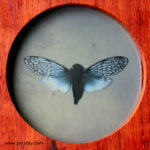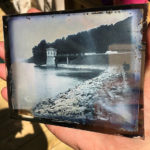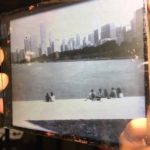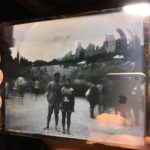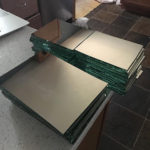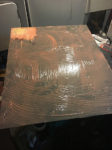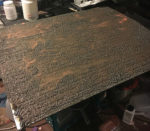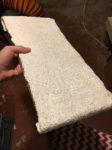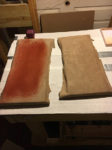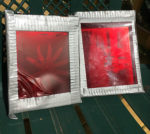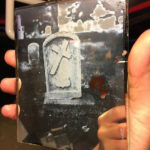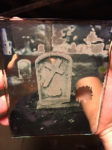A lower cost approach to making daguerreotypes by Jon Hilty
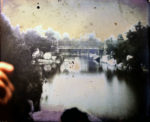 |
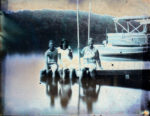 |
|
Daguerreotypes can be a difficult process to explore, due to a reasonably high barrier to entry and and somewhat daunting chemicals involved. Even the Becquerel variant of the process still requires the user to have a fume hood to work with the elemental iodine, work with specialized polishing equipment, and be in possession of costly silver plates.
This guide hopes to help alleviate a few of these issues for the interested amateur. The process outlined here replaces the elemental iodine with common iodine tincture from the pharmacy, saving the user from having to handle more dangerous elemental iodine, as well as doing away with the need for a fume hood or specialized ventilation. The guide also replaces traditional daguerreotype plates with glass plates made from a salvaged mirror.
There are a few differences between glass and traditional daguerreotype plates:
-
 • The silver lining from a mirror is usually only good for one image, while traditional plates can be polished and reused several times.
-
• Large scratches on the mirror surface will often scratch through entirely.
-
• The thin silver lining on a mirror cannot reproduce shadows as deeply as a traditional plate. Excessively thin coatings will also fail to produce highlights effectively.
-
• Any amount of oxidation will most likely flake off the mirror during processing, leaving large holes behind.
-
• The rate at which iodine tincture sensitizes plates is magnitudes slower than elemental iodine, often requiring more close to two hours.
-
• Mirror plates are considerably cheaper than traditional plates, often running about $1-$2 per 4×5 plate after factoring in the cost of material and stripping product.
With this modified process, one will need to adjust their expectations accordingly — I do not believe the tonal range on a glass dag can quite compare to a traditional plate, though I do believe thicker mirror coatings can certainly get very close to the real thing. Dimensional stability is also a concern, as glass has a much lower coefficient of thermal expansion as opposed to silver. Traditional plates are tried and true in this regard. Caution should be taken to treat mirrored glass plates with respect, as they may not be able to take as much abuse as their all-metal counterparts.
Step 1: Preparing the plates
I’m sure a few of your minds immediately jumped to the question: why not silver your own glass? Well, you may be in luck! Andy Stockton’s guide to silvering your own daguerreotype plates is quite informative. I did not have much luck with this method however — I have found that the Angel kit, while good for making mirrors, generally produces a somewhat dull looking surface mirror that has poor adhesion to the glass during fixing. They were notably very difficult to polish as well without accidentally tearing a chunk of the silver off even at the slightest touch. I have not yet tried silvering via a traditional Tollens’ reaction.
In all regards I felt that salvaged mirror glass was a better candidate, since it can take a considerably larger amount of abuse.
The paint backing can be stripped with a product called ‘Citri-Strip’, which is a common paint stripper in the United States that lacks volatile solvents. There are many different types of backings that will react differently — some in as little as 20 minutes and some as long as one day. Ideally, the paint will wrinkle and rise, detaching itself from the mirror surface.
In some cases the entirety of the paint can be gently brushed off with a gloved hand, revealing the copper surface below. Other times, more difficult backings require multiple coats before they will loosen. Multiple coats are required regardless, as the Citri-Strip will eat through the copper layer as well. If there is no more backing remaining, two additional coats (allowing 8 hours / coat) will remove the copper. Take care to minimize the time the silver is in contact with the Citri-Strip, as I believe Citri-Strip also will eat through silver at a reduced rate.
In some cases, certain mirrors have a stubborn backing that softens but will not detach from the mirror. I have not yet found a solution to removing this backing. It appears to be common in newer mirror stock.
After no more copper is visible, gently wash the mirror with soap and water to remove remaining Citri-Strip residue.
The mirror can then be cut to the user’s desired size.
Step 2: Polishing
Polishing is a little easier on these plates than it is with traditional plates, though plates that have been sitting for a few months may receive some defects that cannot be removed. Because of this, it is probably better to shoot the plates in the weeks following a mirror stripping, rather than stockpiling a bunch of plates and allowing them to sit around for months. Your mileage may vary.
I prefer using two buffing paddles – one for rough polishing with rouge, and a second one lacking rouge, which generally serves to remove excess rouge from the first paddle. The paddles are simply wood boards with some layers of felt (as internal padding) with a layer of Ultra-Suede stretched on top. Polishing rouge is dusted on to the first paddle, and the plate gently run up and down against it. I push with less pressure than I would when buffing a traditional plate — the glass sometimes can be a tad sharp and can cut the surface of the Ultra-Suede. Perhaps 50 to 200 strokes, occasionally visually inspecting the plate. Sometimes streaks of rouge stick to the plate for unknown reasons — these should be gently removed with a paper towel, as additional polishing does not seem to remove it.
Some mirror stocks seems to have some sort of blue haze, making it somewhat easier to know when to stop polishing. Run the plate against the second paddle to remove lingering rouge, with about 25-50 strokes. With a paper towel (taking care not to touch parts of the towel that will be touching the plate with your bare hands), gently run across the surface of the mirror to remove the last traces of rouge, followed by a quick wipe of the rest of the plate.
Step 3: Sensitizing
As stated previously, iodine tincture may be purchased from your favorite local pharmacy or general store. Most of my work has revolved around working with 10% povidone-iodine, due to the relative ease at which it can be purchased. A Lugol’s solution of varying strengths will also work, possibly with faster action if you can find concentrations above 2%.
The sensitizing tray lacks the complexities of a traditional iodine sensitizing box. As the rate at which iodine tincture gasses off is hundreds of times slower than in its elemental form, any old tray or dish may work. One should cover the trays with glass when they are not in use to prevent the solution from evaporating and gassing off, otherwise they will slowly iodize things in the immediate vicinity.
Fill the tray carefully with iodine, trying to keep the tray level and a nice 1/8″ gap of air between the liquid surface and the top of the tray. The strength of the iodine tincture’s sensitizing abilities drop off quite quickly as this gap increases. Also take care to not get iodine on the surface of the tray, as stray drops will destroy the silver after extended contact and may fog other parts of the plate.
Lay the mirror plate face down on top of the tray, turn the lights out and… wait! This will be a very slow process. Generally after about 45 minutes, I check the color to see how it is progressing. Usually at this point you can expect a deep yellow with an orange-magenta gradient on the outside. Rotate 180 degrees and continue checking the color periodically. I personally prefer the middle of the plate to be just starting to cross over to a blueish-magenta.
To check the color: I have a piece of ordinary 8.5×11 inch printer paper hung on the wall about 6 feet away. Illuminate the paper with a flashlight while catching the paper’s reflection in the mirror — this will reveal the plate’s current color.
The plate is now ready to be loaded into a plate holder. 1/8″ thick glass does well in a traditional plate holder. Thicker glass (I’ve shot up to 1/4″) can be fitted into a modified Premo film pack adapter.
Step 4: Exposure
I don’t have much to add here currently, as there are so many variables that could affect the speed of the plates. Check out this exposure guide by Jonathan Danforth to get you pointed in the right direction!
Step 5: Development and Fixing
The Becquerel method of developing daguerreotypes involves the plate’s exposure to strong red light. These days a red gel filter called ‘rubylith’ is commonly used by daguerreotypists, though ‘amberlith’ tends to have a faster developing action (if you can get your hands on some, it’s no longer manufactured!).
Place the exposed plate in a light tight box or container — whether it be a pizza box, modified camera back, or the plate holder itself! The amount of time the plate needs exposed to light can vary, so this will need to be determined experimentally — shorter developments result in bluer looking images. Overdeveloping (and excessive heat) can lead to fog. My rules of thumb are usually – 2.5 hours in the sun with rubylith, 1.25 hours with amberlith. If you wish to develop at night (or you expect to go weeks without seeing the sun, as is the case for Michigan winters), a halogen worklight works just fine. Try 4 hours with rubylith (or two hours under amberlith) to start with, and keep a fan blowing on the developing box to keep excess heat from building up.
After 5 – 10 minutes, a negative should begin to form visibly on the plate surface.Â
There is no extreme rush to get the plate processed as in the wet plate process, but care should be taken to get development started within a few hours — the latent image recorded on the plate will begin to degrade. I’ve achieved fantastic results with plates that were shot 6+ hours, but generally I prefer to be prompt about it. After development, the image is stabilized and can be fixed at one’s leisure.
Due to the silver’s lessened adhesion to the glass surface (as compared to traditional plates), a weaker fixing solution should be prepared:
-
• 2.5g sodium thiosulfate (‘hypo’)
-
• 2.5g sodium sulfite
-
• 200mL water
Fix for about one or two minutes, with gentle agitation. You should observe the plate’s color being removed, changing to a more neutral tone. If you observe the silver begin to wrinkle, reduce the amount of agitation. If the silver flakes completely, reduce fixer strength by half. My biggest issues with silver adhesion have been with plates that were silvered at home, as opposed to commercially manufactured mirrors.
Great care must be taken when handling the plates post-exposure — the image is more or less made of a fine dust that is deposited on the plate surface. The plate will easily scratch with the slightest of touches!
Step 6: Gilding (optional)
Gilding provides additional protection to the image (both mechanically and from oxidation) by depositing a thin layer of metallic gold on the plate surface. It also serves to increase the contrast a bit, and gives the plate a warmer tone.
This is probably the most unforgiving step of the process as well as the step I have the least experience with. However, at the time of this writing, I have had 4 successful gilded glass daguerreotypes without any deterioration in the image area. I would recommend practicing on a few bad plates first to get the hang of things.
I use a modified version of cold gilding that I’ve nicknamed ‘warm gilding’ . I noticed with full on cold gilding, there were often odd (usually unpleasant) patterns of gilding impacted on the plate. Attempts at heated gilding with a propane torch (as is typical with gilding traditional plates) have ended in disaster. Warm gilding seems to find a happy medium here.
1. Agitate the plate in warm, soapy water. This will hopefully remove any accidental oil deposits that remain on the plate surface that would normally hinder gilding in those areas.
2. Prepare the following solutions:
-
0.1% Gold chloride in H2O (A)
-
0.4% Sodium thiosulfate in H20 (B)
These solutions should be relatively stable when kept separated. When you are ready to gild, add 10mL of A into 10mL B, allowing it to set about an hour or so.
3. When you are ready to gild, allow the plate and the solution to soak in a tray of hot water (straight from the hot tap of the faucet).
4. With the plate elevated level, splash the surface with some distilled water, drain, and gently pour the heated 20mL of gilding solution on top of the plate, so as to form a meniscus. Allow the solution to remain on the surface for 20 minutes.
You should eventually notice a color change. When you are satisfied, remove the gilding solution and gently wash the plate. The gilding solution will generally make the edges of the plate flake, and rough agitation may cause large portions of the plate to strip off.
Finishing Up
Whether you have decided to gild or not, it is a good idea to carefully dry the plate with a hair drier to avoid unsightly water marks. Splash the surface with distilled water (tap water is NOT a good idea here, there’s a ton of junk that will deposit on the plate) and, holding the plate at about a 30 degree angle, blow dry the water off. The closer the hair drier is to the surface, the better – you want to quickly remove the water to prevent marks, chasing the water and lot leaving behind droplets.
When the plate is completely dry, it should be mounted to a piece of glass to protect the delicate image scratches or oxidation. A spacer (such as paper) should be placed between the plate and the glass to prevent the formation of Newton rings. Seal the edges with some sort of adhesive, such as tape or hot glue. When you finish this… congratulations, you’ve made your very own daguerreotype!
If you’d like to see more of my work, feel free to check out my website here!
